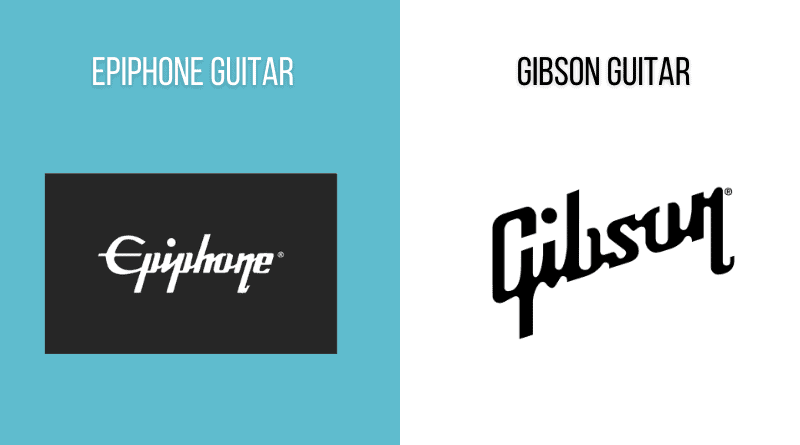Back in 1957, Gibson acquired the Epiphone brand but allowed them to continue production of their own proprietary instruments for many years after. However, in the early ‘80s, Gibson licensed production of Gibson models to the Epiphone brand in order to create an affordable range of equivalent models to their flagship US guitars.
Since then, Gibson’s most popular models, the Les Paul and the SG, have been available under the Epiphone name as the only officially licensed copies of those designs – and naturally, both have dominated their specific segments of the market, with many players graduating from Epiphone to a Gibson in their favored body shape. Of course, this has caused a huge market for both fake Gibson Les Pauls and fake Epiphone Les Pauls, but really – what better tribute to this legacy could there be?
In this KillerGuitarRigs Guide, you’ll learn
- What are the differences between the Gibson Les Paul and the Epiphone Les Paul?
- What are the differences between the Gibson SG and the Epiphone SG?
Contents
- A Quick Note On Our Coverage
- What Are The Differences Between the Gibson Les Paul and the Epiphone Les Paul?
- Les Paul Junior
- Les Paul Studio
- Les Paul Standard 50s/60s
- Les Paul Custom
- What Are The Differences Between the Gibson SG and the Epiphone SG?
- SG Standard
- SG Standard ’61 Reissue
- SG Custom
- Final Thoughts On The Differences Between Gibson and Epiphone Models
A Quick Note On Our Coverage
Both the Gibson and Epiphone stables are packed with an ever-widening array of standard, signature, and limited edition models (to the point where we have a “top 7” list dedicated solely to Epiphone Les Paul models).
This list is not meant to be an exhaustive examination of every Gibson and Epiphone model, but instead only the highlights of the biggest selling models (excepting hollow bodies such as the Gibson ES-335 and ES-339, the Epiphone ES-335, and so forth.)
We have quite a vast array of reviews of both Epiphone and Gibson models (including acoustics like the gone-but-not-forgotten Gibson J-15, the workhorse Gibson G45, and the ever popular Epiphone DR-100), and their alternatives (for example our article on Gibson ES-335 copies) – feel free to use the search function to find more.
What Are The Differences Between the Gibson Les Paul and the Epiphone Les Paul?
There are several common models of Les Paul made by both Gibson and Epiphone – keep reading to find out more about each.
Les Paul Junior
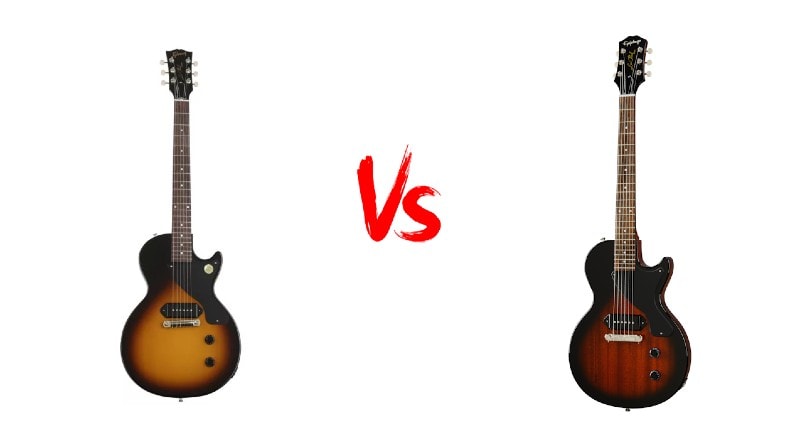
Overview
The Les Paul Junior was the original “budget Les Paul”, and was primarily aimed at students and novice players.
Body
Both the Gibson and the Epiphone Les Paul Junior are made from a slab of mahogany. The most noticeable difference between the two when it comes to the wood is the grain. On the Epiphone, the grain is a lot stripier, and much more noticeable – there is clearly a lot more thought given to wood selection at the Gibson plant.
Finish is also something that sets the two apart – the Epiphone has a hard wearing polyurethane lacquer coating that will stand up will to years of abuse. The Gibson is finished (as most Gibsons are) in an old school nitrocellulose lacquer. Nitro finishes are a lot more time consuming to apply, and therefore more costly, but ultimately the guitar will age in a much more appealing way.
Neck
The neck is another area in which the Gibson and the Epiphone are very similar. Both are made from mahogany, which is great for feel and tone, and both have the infamous Vintage ‘50’s profile. The Vintage ‘50s profile is so thick, it is widely known for feeling like a baseball bat.
The Epiphone model shows some areas in which costs have been cut on the neck, it uses an Indian Laurel fretboard, whereas the Gibson uses a more premium rosewood. Both guitars come with a 12” radius, dot inlay markers, 22 medium jumbo frets, and a Graphtech nut, though it’s worth noting that the Gibson’s nut uses a proprietary formula for increased resonance.
Electronics
The Gibson and The Epiphone Les Paul Junior both ship with a single dogear P90 pickup. The Epiphone uses an Epiphone P-90 Pro, which is pleasant, but definitely not as hot as the Gibson Equivalent today. The tone it delivers is somewhat clean for a P-90, whereas the Gibson dogear P-90 delivers the throaty, angry tones that P-90 players crave.
As for pots, the Epiphone is very well equipped. It features full size CTS USA master tone and volume dials, that provide a nice swell and great tonal control. The Gibson uses Gibson’s own hand wired potentiometers, which are just a little smoother than those on the Epiphone.
Hardware
The most noticeable difference between the Epiphone and the Gibson is that the Epi uses a lightning bar wraparound bridge, whereas the Gibson uses a plain wraparound. The lightning bar is a compensated bridge designed to assist with intonation. The thought process is that the factory setup on the Gibson is typically superior, and thus the additional compensation is not required. Both come with vintage Gibson Deluxe style tuners, although the Epiphone tuners are branded Epiphone Deluxe. Both are smooth and hold tune well.
Les Paul Studio
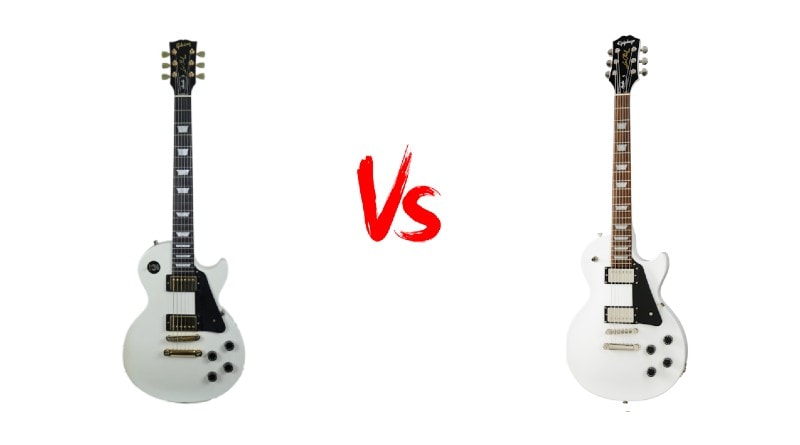
Designed as the “working musician’s” Les Paul, the Studio embodies the spirit of the style while saving weight and cutting cost, making it our Editor’s Choice in our roundup of the best cheap Les Pauls.
Body
The Epiphone and Gibson Les Paul Studio are both made with a mahogany body with a carved maple top and a mahogany neck. The Gibson, however, is weight relieved. Both come in a range of finishes, some of which, like Ebony, Alpine White, and Smokehouse Burst are shared between both Gibson and Epiphone. As you’d expect, you’ll get a PU clearcoat on the Epiphone and nitro lacquer on the Gibson.
Neck
Sticking with the theme of weight saving, the Gibson and the Epiphone both have slim necks. Gibson has installed a regular slim taper on the US-made version, while Epiphone opted for the even slimmer 60’s slim taper “D” profile – both are fast and comfortable. On the Epiphone, the fretboard is Pau Ferro, while the Gibson gets rosewood, which offers a much more tactile feel. Both guitars have the classic trapezoid fret markers, a Graphtech nut, and 22 medium jumbo frets.
Electronics
Pickups are a real differentiator between the Gibson and the Epiphone (though upgrading the pickups is not unheard of in order to level the playing field, as it were). The Epiphone features a matched pair of Epiphone Alnico Classic humbuckers, which offer excellent warmth and good distortion response, although they can lack clarity. The Gibson is also fitted with a pair of humbuckers, but in this case a 490R in the neck and a 498T in the bridge. Both guitars actually feature coil-splitting/tapping, too; by pulling out on the volume knob you’re able to unlock a whole range of single coil tones.
Hardware
Both the Gibson LP Studio and the Epiphone LP Studio are equipped with Grover tuners, in the Epi’s case they’re standard Grover 18:1, which are accurate and provide great stability. The Gibson gets an upgraded set of Grover Rotomatics. At the bridge end, both are equipped with a nickel-plated stopbar tailpiece. The Epiphone is set up with an ABR Tune-O-Matic bridge, while the Gibson gets the Nashville Tune-O-Matic. Both are solid bridges, with the primary difference being that the saddles adjust from the top on the Epiphone, and from the bottom on the Gibson.
Les Paul Standard 50s/60s

Overview
The Gibson Les Paul Standard is the original flagship model. Today, it primarily comes as either a 50s or 60s version in Both Gibson and Epiphone, both offering a slightly different experience based upon the original specs of those eras. Epiphone have also started doing “limited edition” versions since their latest revamp – for example we recently reviewed the 1959 Les Paul Standard – so depending on when you read this, there may be even more options available.
Body
Both the 50s and 60s versions of the Epiphone and Gibson Les Paul Standards come with a solid mahogany body topped with a carved maple cap for additional clarity and snap. There is little difference between the Gibsons and the Epiphones, although the grade of the maple on the Gibson examples is far superior, giving a much more aesthetically pleasing flamed effect. For added visual effect, all 50s and 60s LPs from Gibson and Epiphone have binding on the top side of the body only, and for finish the Epiphone LP Standards have polyurethane, while the Gibsons get nitro.
Neck
Mahogany is used throughout the entire range from Gibson and Epiphone, but the neck profiles differ depending on which brand you choose. The 50s Epiphone gets a ’59 Rounded Medium C, which is noticeably slimmer than the Les Paul Standard ‘50s on the 50s Gibson Standard. On the 60s models, the Epiphone has a Slim taper 60s C shape, which is, again, slimmer than the Gibson, which has the Les Paul Standard 60s neck. Epiphones get Indian Laurel Fretboards, and the Gibsons get rosewood. All models have bound necks, trapezoid fret markers, and 22 medium jumbo frets.
Electronics
The Epiphones are equipped with CTS pots and wiring, and a pair of Probucker pickups with Alnico II magnets, and are voiced for warm tones with bell like highs. The Gibsons are fitted with period correct Burstbuckers that deliver incredible vintage PAF tone.
Hardware
Hardware, like everything else on these guitars is period correct. All models get ABR Tune-O-Matic bridges. The 50s models get Vintage Deluxe tuners, while the 60s models are treated to 18:1 Grover Rotomatic tuners – tuning stability is solid across the board.
Les Paul Custom
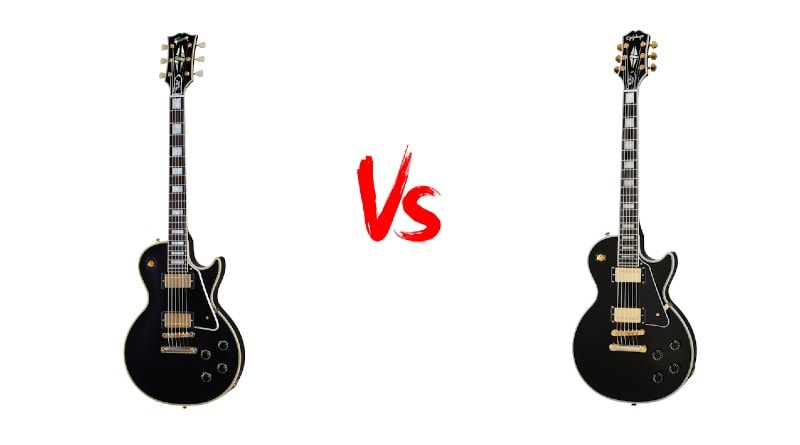
Often referred to as the “tuxedo” guitar, the Les Paul Custom comes with premium appointments and design features not found on any other model.
Body
The Deluxe models, both Epiphone and Gibson are only available in Tuxedo colors, Ebony, and Alpine White. Construction is mahogany, with the customary carved maple top. They have fully bound bodies, front and back and contrasting pickguards. There is very little discernable difference between the Gibson and the Epiphone when it comes to the body.
Neck
Both the Epiphone and the Gibson have lightning fast, solid mahogany necks with slim taper profiles. The Epiphone is actually fitted with the same luxurious ebony fretboard as the Gibson, which really goes to show how incredible the value of the Epiphone model is. Both the neck and headstock are fully bound on both brands and both have 22 medium jumbo frets. A difference maker here is that the Epiphone gets pearloid block inlay, whereas the Gibson boasts genuine mother of pearl.
Electronics
Of course, both brands are equipped with 2 humbuckers and a 3 way toggle switch, but it’s the wiring of those pickups that makes the difference. The Epiphone gets the same Probuckers as the Standard models, while the Gibson is treated to the ultra clear Gibson 490R and 498T pups.
Hardware
As this is the Custom model, gold hardware is found on both models, including tuners, bridge, output jack, pickguard bracket, and pickup covers. Both the Gibson and the Epiphone are equipped with Tune-O-Matic bridges with stopbar tailpieces. The control knobs are the only non-gold hardware on board, and rather than the top hat dials featured on all of the other models, the Custom gets clear speed knobs on the Gibson and the Epiphone
What Are The Differences Between the Gibson SG and the Epiphone SG?
Keep reading to find out all about the similarities between the original Gibson SG and its licensed copy, the Epiphone SG. While both Epiphone and Gibson make a fairly wide variety of SGs, from the ultra budget Epiphone SG Special all the way up to signature Gibson SG Customs, we focused again on the core models.
SG Standard
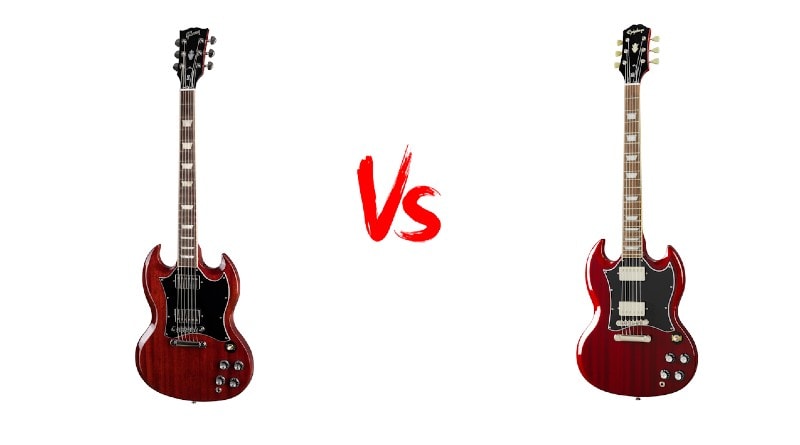
The SG Standard is a guitar that helped to define the hard rock genre. It boasts iconic looks, superb performance and is a lot more versatile than many give it credit for.
Body
The Gibson SG Standard is constructed around a beautiful mahogany body, as is the Epiphone. The prime difference being the nitrocellulose finish on the Gibson and the hard wearing polyurethane lacquer on the Epiphone. Both guitars have the iconic “devil horn” double cut, and superb ergonomics thanks to the shaped body.
Neck
On the Epiphone, you’ll find a ‘60s slim taper neck shape that comfortable for everyone from beginners to experts, where on the Gibson you get a beefy, round neck profile. If you are in to thicker necks, the Gibson is incredibly comfortable, and definitely fast for having a thicker neck.
The fretboard is bound on both guitars, they come with 22 medium jumbo frets, and you’ll get a pleasant, if unremarkable Indian laurel Fretboard on the Epi, or a plush rosewood board on the Gibson. Fret markers are trapezoid (pearloid on Epiphone, acrylic on Gibson), and both guitars get a sweet Graphtech nut that helps with tuning stability, tone, and string longevity.
Electronics
This is another area in which the Gibson shines bright over the Epiphone – the Gibson SG is loaded with 2 humbuckers, both perfectly voiced for this guitar’s incredible versatility. There is a Gibson 490R in the neck, and a 490T in the bridge. These pickups span the genres, and can hit the cleans required by country twangers, or they can own the crunch that hard rockers need. On the Epiphone, you get a matched pair of Alnico Classic Pro humbuckers. They are definitely adequate, and can handle most genres, but they do lack the finesse that you find in the Gibsons.
Potentiometers are quality across the board. The Epiphone gets high end quarter sized CTS USA pots, and the Gibson is supplied with hand wired Gibson models. Both offer smooth tapering for huge tonal variety.
Hardware
Other than the obvious differences between the headstock shape, the only other visual giveaway between the two guitars is the tuners. The Gibson features nickel plated Grover Rotomatics, whereas the Epiphone gets Epiphone Deluxe vintage style, regardless of the difference, both offer excellent stability and smooth action.
Look very closely, and the trained eye might also notice that the Gibson sports a Nashville Tune-O-Matic bridge, whereas the Epiphone has an ABR Tune-O-Matic. The difference is slight, but the Gibson bridge is definitely an upgrade. Finally, both guitars are equipped with the more contemporary 3 ply “batwing” pickguard.
SG Standard ’61 Reissue
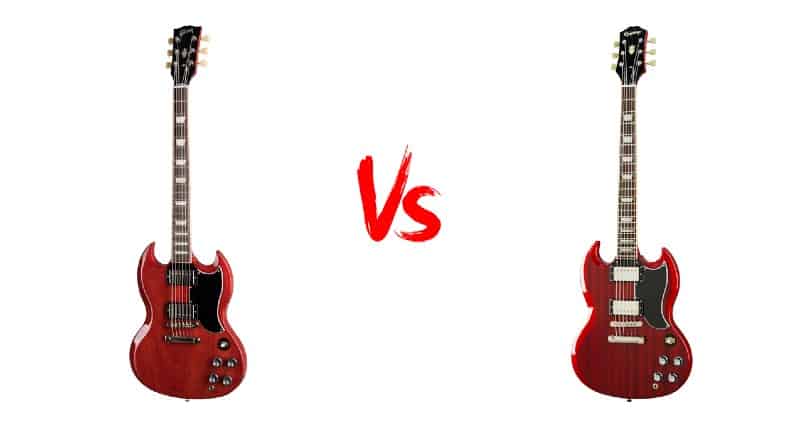
The SG Standard ’61 Reissue is an authentic remake of the very first Gibson SG, as it was made back in 1961, back when it became an instant icon.
Body
The body on both the Epiphone and the Gibson is the same comfortable, tapered, double-cut mahogany slab as you find on the SG Standard; after all, it’s this warm, resonant mahogany that drives the unmistakable SG tones. finishes are also the same – polyurethane on the Epiphone and gloss nitro on the Gibson. It’s believed by many that the use of a nitrocellulose lacquer allows the wood of the guitar to breathe, which improves resonance and overall tone
Neck
Both the Gibson and the Epiphone have mahogany necks in the same slim taper profile that was used on the original 1961 classic. It’s fast and comfortable, and ideal for players of all skill levels. Both instruments have Graphtech nuts, 22 medium jumbo frets, and bound fretboards.
The biggest difference between the two is the fretboard material, which in the Epiphone’s case is Indian laurel, versus the rosewood found on the Gibson. The Indian laurel is much more open-grained than rosewood, which can feel rough depending on the cut that was selected during manufacturing.
Electronics
The Epiphone is equipped with the brand’s go-to vintage style pickups, the Probuckers, while the Gibson has matched Burstbuckers. The Burstbuckers are significantly hotter than the Probuckers, which helps to voice the hard rock snarl that the SG has become famous for. As with the standard, Epiphone has ensured smooth volume and tone taper by equipping CTS pots, while Gibson has opted for in-house designed and wired controls.
Hardware
The most striking difference between the ’61 reissue and the regular standard is the half-pickguard. Both the Epiphone and the Gibson have the same 3-ply scratch plate, Vintage Deluxe Tuners, and black top hat knobs. Both are equipped with nickel-plated Tune-O-Matic bridges and pickup covers, too.
The ’61 issue can also be bought with a Maestro Vibrola Tremolo System on both the Epiphone and the Gibson Models. Both have the iconic harp engraving, and they look incredible. The Maestro system isn’t going to allow EVH divebombs, but it does provide a way to squeeze more tonal diversity out of the SG.
SG Custom
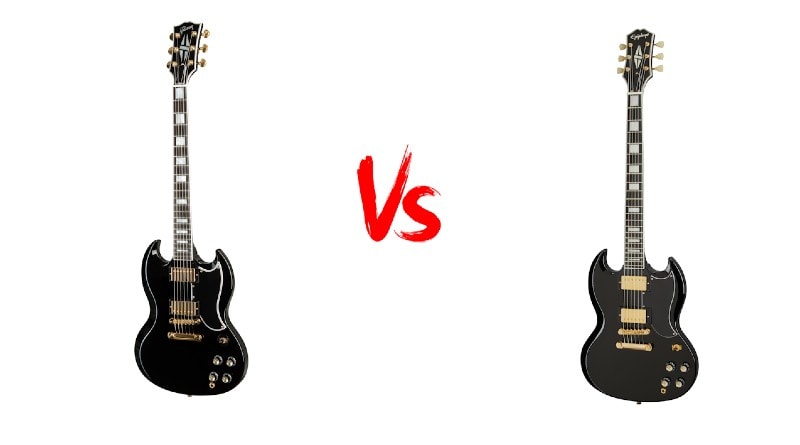
The SG Custom is the pinnacle of SG design, loaded with high-end trim, and attitude for days.
Body
The SG Custom stands apart from all other SG models here. While still made from mahogany, the Custom is crafted from a single piece, a technique that requires an artisan luthier to find and select the perfect piece of wood in order to carve the body. The Epiphone, per the other SG models, is also made from mahogany, but from joined pieces.
Neck
Both the Epiphone and the Gibson get slim taper necks, fully bound necks and headstocks, and 22 medium jumbo frets on their ebony fretboards. The Gibson is further upgraded over the Epiphone on the fretboard, where you’ll find genuine mother pearl inlay.
The Gibson is also PLEK’d, and the action is about as perfect as an action can be. You’ll be able to play huge bends with no choke-ups, and playability is overall second to none.
Electronics
On the Gibson, you’ll find a pair of Gibson-designed and built humbuckers, a 490R in the neck, and a 498T in the bridge position. They are extra crunchy under high gain but sweet and clear when played clean. On the Epiphone, you get a matched pair of Alnico Custom Pro humbuckers, which are voiced exclusively for the SG Custom. They are at the top end of pickups offered from Epiphone and, in their own right, are excellent all-rounders that can handle cleans and distortion well.
Hardware
As is typical on Gibson and Epiphone custom models, the hardware is gold. Both have Tune-O-Matic bridges, pickup covers, and gold-capped top hat dials. The Gibson is fitted with Grover Rotomatic tuners with kidney-style knobs, while the Epiphone, disappointingly, features gold-shafted vintage classic tuners with plastic ivory knobs.
Final Thoughts On The Differences Between Gibson and Epiphone Models
Especially since the introduction of Epiphone’s Inspired By Gibson Line, the gap between the two brands, both quality and materials-wise, has closed significantly. Yes, the Gibson instruments are still superior (vastly in some cases), and there is unlikely ever to be a mass-produced instrument that can match the quality of a handmade equivalent, but the advent of CNC machining has really improved the consistency in Epiphone’s quality, something they were infamous for in years gone by – and with the upgrade market for both as hot as ever, you can narrow the gap as you see fit.
With the current direction that Epiphone are moving in, it is incredibly hard to deny what phenomenal value for money they now represent when you consider how similar they are compared to many of their Gibson counterparts in everything but price tag!

